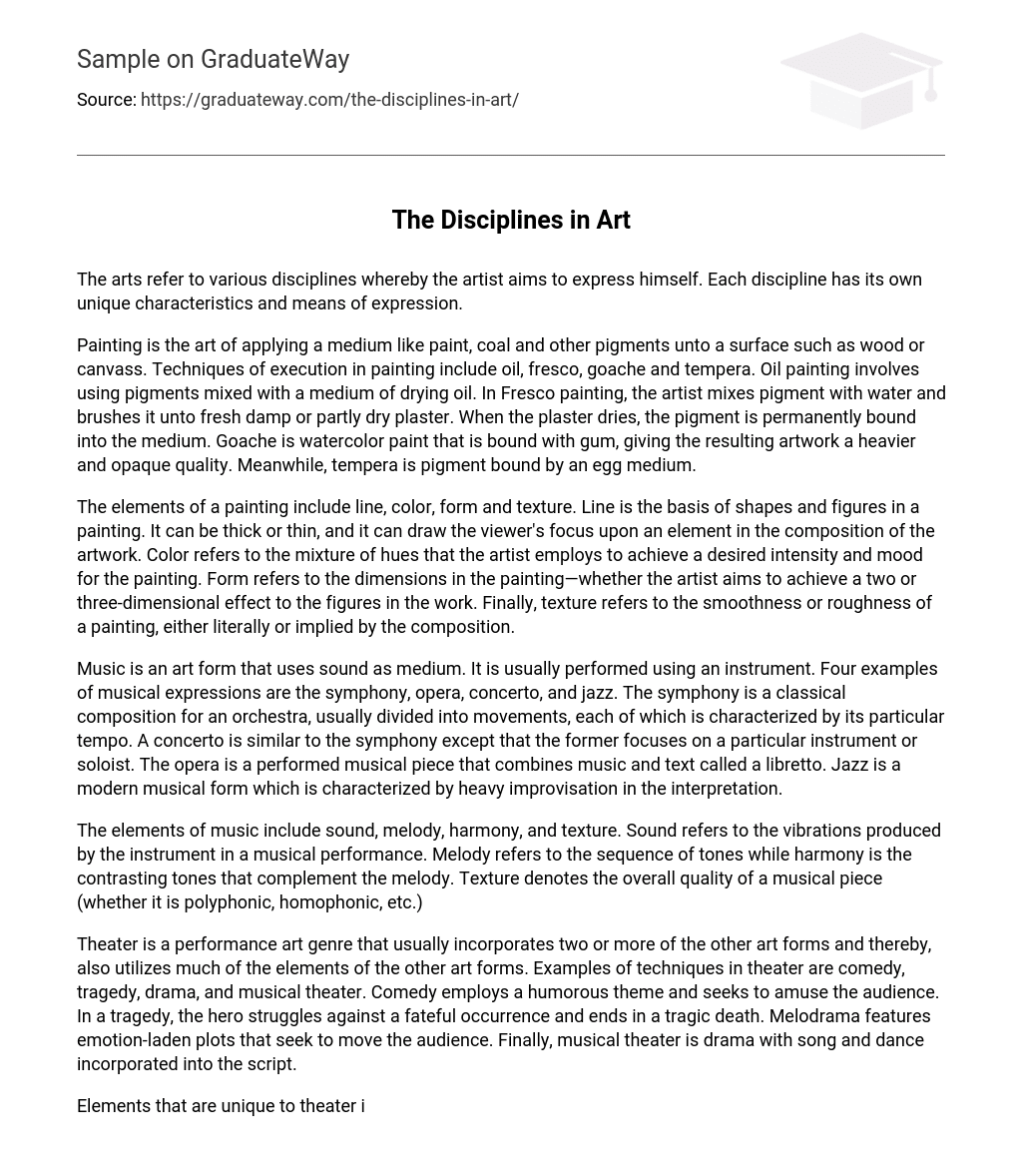The arts refer to various disciplines whereby the artist aims to express himself. Each discipline has its own unique characteristics and means of expression.
Painting is the art of applying a medium like paint, coal and other pigments unto a surface such as wood or canvass. Techniques of execution in painting include oil, fresco, goache and tempera. Oil painting involves using pigments mixed with a medium of drying oil. In Fresco painting, the artist mixes pigment with water and brushes it unto fresh damp or partly dry plaster. When the plaster dries, the pigment is permanently bound into the medium. Goache is watercolor paint that is bound with gum, giving the resulting artwork a heavier and opaque quality. Meanwhile, tempera is pigment bound by an egg medium.
The elements of a painting include line, color, form and texture. Line is the basis of shapes and figures in a painting. It can be thick or thin, and it can draw the viewer’s focus upon an element in the composition of the artwork. Color refers to the mixture of hues that the artist employs to achieve a desired intensity and mood for the painting. Form refers to the dimensions in the painting—whether the artist aims to achieve a two or three-dimensional effect to the figures in the work. Finally, texture refers to the smoothness or roughness of a painting, either literally or implied by the composition.
Music is an art form that uses sound as medium. It is usually performed using an instrument. Four examples of musical expressions are the symphony, opera, concerto, and jazz. The symphony is a classical composition for an orchestra, usually divided into movements, each of which is characterized by its particular tempo. A concerto is similar to the symphony except that the former focuses on a particular instrument or soloist. The opera is a performed musical piece that combines music and text called a libretto. Jazz is a modern musical form which is characterized by heavy improvisation in the interpretation.
The elements of music include sound, melody, harmony, and texture. Sound refers to the vibrations produced by the instrument in a musical performance. Melody refers to the sequence of tones while harmony is the contrasting tones that complement the melody. Texture denotes the overall quality of a musical piece (whether it is polyphonic, homophonic, etc.)
Theater is a performance art genre that usually incorporates two or more of the other art forms and thereby, also utilizes much of the elements of the other art forms. Examples of techniques in theater are comedy, tragedy, drama, and musical theater. Comedy employs a humorous theme and seeks to amuse the audience. In a tragedy, the hero struggles against a fateful occurrence and ends in a tragic death. Melodrama features emotion-laden plots that seek to move the audience. Finally, musical theater is drama with song and dance incorporated into the script.
Elements that are unique to theater include the script, costumes, lighting and stage setting. The script contains the lines of dialogue or lyrics to be performed. Costumes refer to the wardrobe of the performing cast. Lighting refers to the artistic use of stage lights to correspond the needs of the plot while stage setting refers to the props, backdrop and other implements needed to recreate the setting needs of the script.
Dance involves the artful movements of the body, usually to the accompaniment of music. Four means of expressions in dance include ballet, folk dance, ballroom dancing, and hip-hop. Ballet is a formalized and highly-technical dance form with its own terminologies and steps. Folk dances are traditional and cultural dances of the common people performed during social events. Hip-hop dancing is of African-American influence and it accompanies hip-hop music. Ballroom dancing, meanwhile, is the term for types of partner dances usually performed in social venues.
As in theater, dance utilizes elements in music, but certain elements unique to dance are movement, line form, rhythm, and mime. Movement refers to the choreography or series of steps that constitute the dance piece. Line form refers to the patterns that the human body conforms to during movements. Rhythm denotes the sequences of movements while mime is the meaningful theatrical actions of the dancers to express a meaning or message in their movements.
References
Davison, Brandi. “A painting critique: the battle of the Amazons, heart of the Andes, and Volga boatmen,” Associated Content. Updated on 08 December 2006. Retrieved on 09 February 2009 from http://www.associatedcontent.com/article/93533/ a_painting_critique_the_battle_of_the.html?cat=2
Jewell, Richard. Experiencing the Humanities. Updated on 27 March 2006. Retrieved on 08 February 2009 from http://www.tc.umn.edu/~jewel001/humanities/book /0contents.htm





